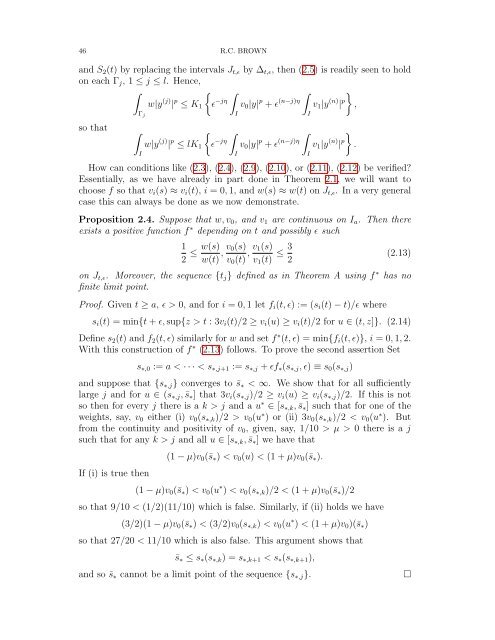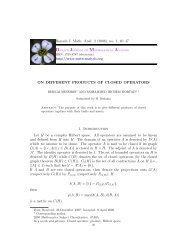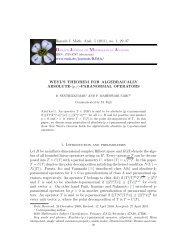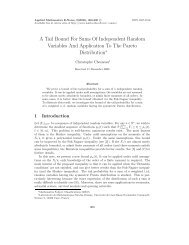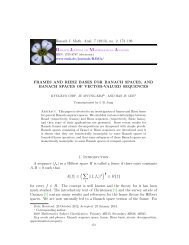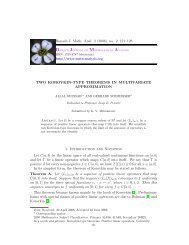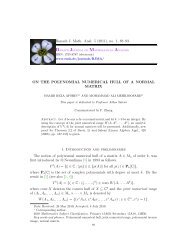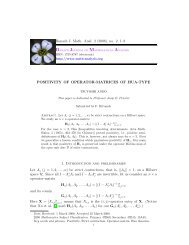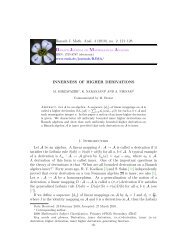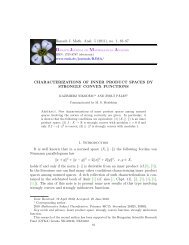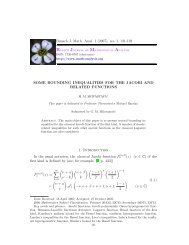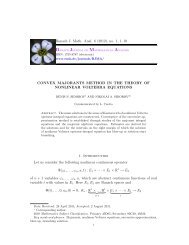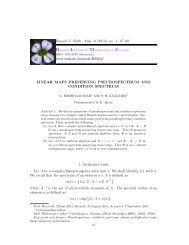Some weighted sum and product inequalities in L^ p spaces and ...
Some weighted sum and product inequalities in L^ p spaces and ...
Some weighted sum and product inequalities in L^ p spaces and ...
Create successful ePaper yourself
Turn your PDF publications into a flip-book with our unique Google optimized e-Paper software.
46 R.C. BROWN<strong>and</strong> S 2 (t) by replac<strong>in</strong>g the <strong>in</strong>tervals J t,ɛ by ∆ t,ɛ , then (2.5) is readily seen to holdon each Γ j , 1 ≤ j ≤ l. Hence,∫∫ }w|y∫Γ (j) | p ≤ K 1{ɛ −jη v 0 |y| p + ɛ (n−j)η v 1 |y (n) | p ,jso that∫Iw|y (j) | p ≤ lK 1{ɛ −jη ∫IIv 0 |y| p + ɛ (n−j)η ∫IIv 1 |y (n) | p }.How can conditions like (2.3), (2.4), (2.9), (2.10), or (2.11), (2.12) be verified?Essentially, as we have already <strong>in</strong> part done <strong>in</strong> Theorem 2.1, we will want tochoose f so that v i (s) ≈ v i (t), i = 0, 1, <strong>and</strong> w(s) ≈ w(t) on J t,ɛ . In a very generalcase this can always be done as we now demonstrate.Proposition 2.4. Suppose that w, v 0 , <strong>and</strong> v 1 are cont<strong>in</strong>uous on I a . Then thereexists a positive function f ∗ depend<strong>in</strong>g on t <strong>and</strong> possibly ɛ such12 ≤ w(s)w(t) , v 0(s)v 0 (t) , v 1(s)v 1 (t) ≤ 3 2(2.13)on J t,ɛ . Moreover, the sequence {t j } def<strong>in</strong>ed as <strong>in</strong> Theorem A us<strong>in</strong>g f ∗ has nof<strong>in</strong>ite limit po<strong>in</strong>t.Proof. Given t ≥ a, ɛ > 0, <strong>and</strong> for i = 0, 1 let f i (t, ɛ) := (s i (t) − t)/ɛ wheres i (t) = m<strong>in</strong>{t + ɛ, sup{z > t : 3v i (t)/2 ≥ v i (u) ≥ v i (t)/2 for u ∈ (t, z]}. (2.14)Def<strong>in</strong>e s 2 (t) <strong>and</strong> f 2 (t, ɛ) similarly for w <strong>and</strong> set f ∗ (t, ɛ) = m<strong>in</strong>{f i (t, ɛ)}, i = 0, 1, 2.With this construction of f ∗ (2.13) follows. To prove the second assertion Sets ∗,0 := a < · · · < s ∗,j+1 := s ∗,j + ɛf ∗ (s ∗,j , ɛ) ≡ s 0 (s ∗,j )<strong>and</strong> suppose that {s ∗,j } converges to ¯s ∗ < ∞. We show that for all sufficientlylarge j <strong>and</strong> for u ∈ (s ∗,j , ¯s ∗ ] that 3v i (s ∗,j )/2 ≥ v i (u) ≥ v i (s ∗,j )/2. If this is notso then for every j there is a k > j <strong>and</strong> a u ∗ ∈ [s ∗,k , ¯s ∗ ] such that for one of theweights, say, v 0 either (i) v 0 (s ∗,k )/2 > v 0 (u ∗ ) or (ii) 3v 0 (s ∗,k )/2 < v 0 (u ∗ ). Butfrom the cont<strong>in</strong>uity <strong>and</strong> positivity of v 0 , given, say, 1/10 > µ > 0 there is a jsuch that for any k > j <strong>and</strong> all u ∈ [s ∗,k , ¯s ∗ ] we have thatIf (i) is true then(1 − µ)v 0 (¯s ∗ ) < v 0 (u) < (1 + µ)v 0 (¯s ∗ ).(1 − µ)v 0 (¯s ∗ ) < v 0 (u ∗ ) < v 0 (s ∗,k )/2 < (1 + µ)v 0 (¯s ∗ )/2so that 9/10 < (1/2)(11/10) which is false. Similarly, if (ii) holds we have(3/2)(1 − µ)v 0 (¯s ∗ ) < (3/2)v 0 (s ∗,k ) < v 0 (u ∗ ) < (1 + µ)v 0 )(¯s ∗ )so that 27/20 < 11/10 which is also false. This argument shows that¯s ∗ ≤ s ∗ (s ∗,k ) = s ∗,k+1 < s ∗ (s ∗,k+1 ),<strong>and</strong> so ¯s ∗ cannot be a limit po<strong>in</strong>t of the sequence {s ∗,j }.□


